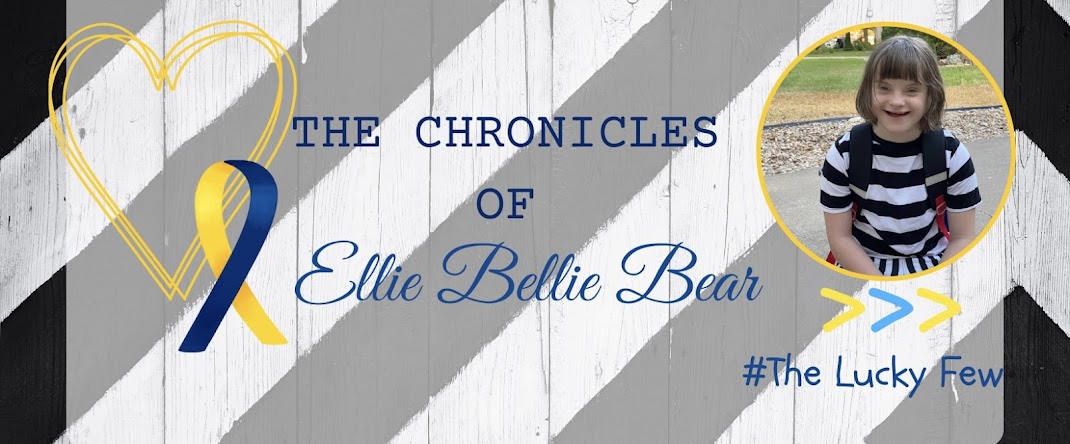
Yes, I know it is long and sort of reads like a research paper :oP
Okay, it is time for another one of my more serious posts. Part One is about Down Syndrome in general, the history, & types of DS and I hope that you take the time to read this very long post. (Tomorrow will include Part 2: common medical conditions, developmental milestones, and expectations).
Disclaimer: The information was given to Andrew and me at our genetics appointment. Some of the information I already knew and others I did not. Please remember that these are just numbers and risks. Yes, some of these things freaked me out, but I just need to remember that Ellie Bear is not a number or a percentage but is a strong, brilliant baby who is already amazed us in so many ways. She is a super star as are other children with special needs.
The photo located on here show a Trisomy 21 karotype and is courtesy of the NDSS. You will need to click on the image to enlarge it.
General:
Down Syndrome is the most frequently occurring chromosomal abnormality—approximately 1 in 800 LIVE births (1). Unfortunately many fetuses are aborted when it is discovered that they have DS so it may actually occur even more frequently. More than 350,000 people in the
History:
So DS has been around for a very long time, but as with anything it took awhile for someone to actually get the news out there. Then of course they assigned their own name to the syndrome thus making them famous. Such was the case with Dr. John Langdon Down of
It wasn’t until 1959 when Dr. Jerome Lejeune (do not ask me to pronounce that) said that DS is a chromosomal condition consisting of 47 chromosomes instead of the typical 46. Andrew likes to think that Ellie was going for extra credit in utero. Our Bear-Bear is an over-achiever in training!
Ever hear of the Human Genome Project? Well that has caused a great many advances in health care. In 2000, a large team of extremely smart scientists identified over 300 genes located on the 21st chromosome. This includes genes for Alzheimers, leukemia, blood disorders, and other things that I never even learned about in NP school. Imagine having an extra chromosome with these genes on it. That would explain why Ellie and others might have a higher chance of developing some of these illnesses such as Alzheimer’s.
Testing:
Okay, I know this is what everyone really wants to know since it has been asked of me by so many people. Did I get prenatal testing?
My answer is sort of.
I did not get the blood test aka quad screen done. Most insurance companies do not cover it and it is not really accurate in my opinion. Plus, even if it showed a problem what would Andrew and I do? Nothing. Well actually I would worry and worry and worry some more. I did however have a 14 wk and 19 wk ultrasound. Everything was completely normal—even the nuchal fold which can be indicative of DS, Trisomy 18, and one other trisomy condition which I cannot remember right now.
“It is important to note that screening tests are of limited value” (1, p. 9)
The blood testing is often done in conjunction with an ultrasound. Remember I had the ultrasound. The quad screen has high percentages of false positives at 8% (just think of all the poor babies that were aborted who were actually normal and those who were with DS. Ellie Bear!) and false negatives at 40% (think of all of the stress it causes the parents throughout the pregnancy). The quad screen detects about 60-65% of all incidences of DS (1).
Types of DS:
1.Mosaicism. This is where some of the cells have 46 chromosomes while others have 47 chromosomes with the 47th being #21. This is thought to be genetic and makes up on 1-2 % of DS cases.
2. Translocation is where part of the 21st chromosome breaks off and attaches itself to another chromosome.
3. Trisomy 21. This makes up 95% of DS cases. This is actually the one that I am going to focus on. This is where every cell has 47 chromosomes with the extra being #21.
Dr. Immeken was adamant that this was no one’s fault. This was something that I really needed to hear. Trisomy 21 occurs at conception (3). While most of the time it is the egg that might contribute the extra chromosome, it can be the sperm (3). I like to think that Ellie is 51% me and 49% Andrew. That being said, when she is naughty, I might claim she is more Andrew than me. . .
References:
1. National Down Syndrome Society. (unknown date). “Down Syndrome”. p. 1-16.
2 American
3. Dr. Ladonna Immken. (Dell Children's Hospital). Personal Communication


No comments:
Post a Comment
I love your comments and I read each and every single one of them.